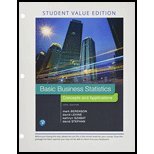
Concept explainers
The following is the
a. Predict
b. Suppose that the computed
c. Suppose that the computer
d. Suppose the regression coefficient for the linear effect is
a.
Determine the predicted value of Y.
Answer to Problem 1PS
The predicted value of Y is 17.
Explanation of Solution
The quadratic regression equation is given as:
For predicting the value of Y for
Thus, the predicted value can be calculated as:
Therefore, the predicted value of Y is 17.
b.
Test whether a quadratic model is better than linear model, if the test statistics for quadratic regression coefficient is 2.35
Answer to Problem 1PS
The quadratic model is better than linear model.
Explanation of Solution
It is given that the value of the test statistics
The null and alternative hypotheses can be constructed as:
The degrees of freedom
This is a two tailed test. So, the upper critical region will be
The critical value of t statistics from t distribution table, which is given in appendix table E.3 at
The decision rule on the basis of the critical value approach:
If,
If,
Since,
Therefore, there is a sufficient evidence to conclude that quadratic model is better than linear model.
c.
Test whether a quadratic model is better than linear model, if the test statistics for quadratic regression coefficient is 1.17
Answer to Problem 1PS
The quadratic model is not better than linear model.
Explanation of Solution
It is given that the value of the test statistics
The hypothesis and the critical value of test statistics is same as above.
Since,
Therefore, there is a sufficient evidence to conclude that quadratic model is not better than the linear model.
d.
Predict Y, when coefficient for the linear effect is
Answer to Problem 1PS
The predicted value of Y is 5.
Explanation of Solution
The regression coefficient for the linear model is given as
Thus, the quadratic regression equation for 25 sample will change to:
For predicting the value of Y for
Thus, the required predicted value is,
Therefore, the predicted value of Y is 5.
Want to see more full solutions like this?
Chapter 15 Solutions
Basic Business Statistics, Student Value Edition
- A company found that the daily sales revenue of its flagship product follows a normal distribution with a mean of $4500 and a standard deviation of $450. The company defines a "high-sales day" that is, any day with sales exceeding $4800. please provide a step by step on how to get the answers in excel Q: What percentage of days can the company expect to have "high-sales days" or sales greater than $4800? Q: What is the sales revenue threshold for the bottom 10% of days? (please note that 10% refers to the probability/area under bell curve towards the lower tail of bell curve) Provide answers in the yellow cellsarrow_forwardFind the critical value for a left-tailed test using the F distribution with a 0.025, degrees of freedom in the numerator=12, and degrees of freedom in the denominator = 50. A portion of the table of critical values of the F-distribution is provided. Click the icon to view the partial table of critical values of the F-distribution. What is the critical value? (Round to two decimal places as needed.)arrow_forwardA retail store manager claims that the average daily sales of the store are $1,500. You aim to test whether the actual average daily sales differ significantly from this claimed value. You can provide your answer by inserting a text box and the answer must include: Null hypothesis, Alternative hypothesis, Show answer (output table/summary table), and Conclusion based on the P value. Showing the calculation is a must. If calculation is missing,so please provide a step by step on the answers Numerical answers in the yellow cellsarrow_forward
 Functions and Change: A Modeling Approach to Coll...AlgebraISBN:9781337111348Author:Bruce Crauder, Benny Evans, Alan NoellPublisher:Cengage LearningAlgebra & Trigonometry with Analytic GeometryAlgebraISBN:9781133382119Author:SwokowskiPublisher:Cengage
Functions and Change: A Modeling Approach to Coll...AlgebraISBN:9781337111348Author:Bruce Crauder, Benny Evans, Alan NoellPublisher:Cengage LearningAlgebra & Trigonometry with Analytic GeometryAlgebraISBN:9781133382119Author:SwokowskiPublisher:Cengage College AlgebraAlgebraISBN:9781305115545Author:James Stewart, Lothar Redlin, Saleem WatsonPublisher:Cengage Learning
College AlgebraAlgebraISBN:9781305115545Author:James Stewart, Lothar Redlin, Saleem WatsonPublisher:Cengage Learning Algebra and Trigonometry (MindTap Course List)AlgebraISBN:9781305071742Author:James Stewart, Lothar Redlin, Saleem WatsonPublisher:Cengage Learning
Algebra and Trigonometry (MindTap Course List)AlgebraISBN:9781305071742Author:James Stewart, Lothar Redlin, Saleem WatsonPublisher:Cengage Learning Big Ideas Math A Bridge To Success Algebra 1: Stu...AlgebraISBN:9781680331141Author:HOUGHTON MIFFLIN HARCOURTPublisher:Houghton Mifflin Harcourt
Big Ideas Math A Bridge To Success Algebra 1: Stu...AlgebraISBN:9781680331141Author:HOUGHTON MIFFLIN HARCOURTPublisher:Houghton Mifflin Harcourt Glencoe Algebra 1, Student Edition, 9780079039897...AlgebraISBN:9780079039897Author:CarterPublisher:McGraw Hill
Glencoe Algebra 1, Student Edition, 9780079039897...AlgebraISBN:9780079039897Author:CarterPublisher:McGraw Hill





